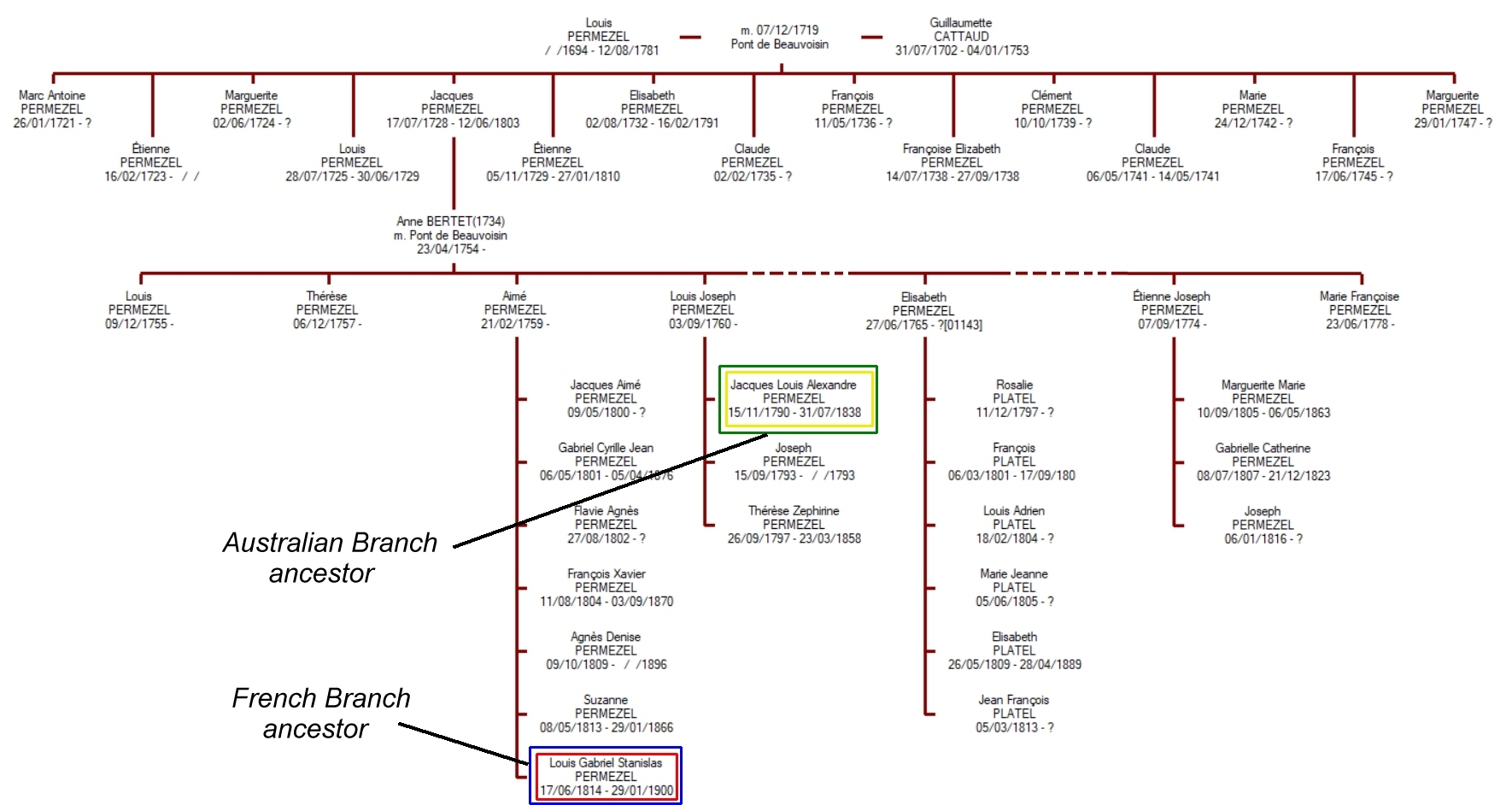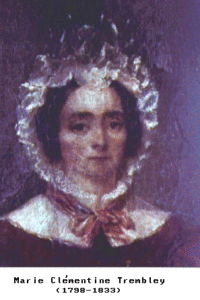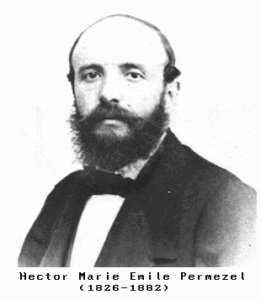An Early History of the Permezel Family

The actual origin of the name Permezel is unclear1. The earliest Permezel known is Loys(Louis), born about 1570, who was churchwarden and parish clerk at Domassin, Savoie in 16232. Domassin is located a few kilometres from the then border with France at Pont de Beauvoisin. At the end of the 17th. century, the family moved to the Pont. The town straddled the border and it is assumed that they moved to the French part of the town.
 Louis, who was born in 1694 at Domassin and probably the great grandson of Loys, married, on 7 February 1719, Guillaumette Cattaud, the daughter of Etienne and Françoise (née Corbet). They had fifteen children all of whom were born at Pont-de-Beauvoisin but most died at an early age. The eldest son was Marc (1721) but it is assumed he did not survive to adulthood as only the date of his baptism is known and there is only detailed information in relation to five. Etienne (1729) became a White Friar monk at Vienne and died in 1810. Elisabeth (1732) married Jean Gonin and had no children. Françoise (1738) married Jean Bourier (more probably Bouvier) and nothing more is known. Clément (1739) married Marie Françoise Dussansoy in Lyon and died on 6 January 1772 but nothing further is known. It is from the fourth son Jacques (1728) who was a merchant that the present family descends.
Louis, who was born in 1694 at Domassin and probably the great grandson of Loys, married, on 7 February 1719, Guillaumette Cattaud, the daughter of Etienne and Françoise (née Corbet). They had fifteen children all of whom were born at Pont-de-Beauvoisin but most died at an early age. The eldest son was Marc (1721) but it is assumed he did not survive to adulthood as only the date of his baptism is known and there is only detailed information in relation to five. Etienne (1729) became a White Friar monk at Vienne and died in 1810. Elisabeth (1732) married Jean Gonin and had no children. Françoise (1738) married Jean Bourier (more probably Bouvier) and nothing more is known. Clément (1739) married Marie Françoise Dussansoy in Lyon and died on 6 January 1772 but nothing further is known. It is from the fourth son Jacques (1728) who was a merchant that the present family descends.
Jacques was baptised on 17 July 1728 and married Anne Bertet on 23 April 1754. Anne (c.1730) was the daughter of François and Elisabeth (née Drevet). The contract of marriage was sealed before Maitre Guilland, Notary, on 8 April of the same year. Jacques, like his father was a merchant, and was Secretary and Town Clerk of Pont de Beauvoisin in 1760. Jacques and Anne also had fifteen children, one of whom, Louis (1760) is the ancestor of the junior branch of the family, which includes the Australian branch. The eldest son was Joseph (1756) who died at the age of 12. It is from the second son Aimé (1759) that the present senior (French) branch has descended. The only other known descendants of Jacques and Anne are from the marriage of their third daughter Elisabeth (1765) to François Platel. The members of this branch also live in France.
Louis, the progenitor of the Australian Permezel Family married, on 18 January 1790, Catherine Joannis, daughter of Sébastian and Catherine (née Languier). Catherine was born at Josier in the Bas Alpes, very close to the present Italian border and then probably in Savoie. The marriage took place at Domassin, Savoie, from where the family had moved a century earlier. Her great uncle, Father Laurans, was the priest at Domassin who left her an inheritance – probably property in the area, which probably explains Catherine’s movement from Josier to Domassin at an early age. Louis and Catherine lived in Pont-de-Beauvoisin and their house was still standing in 19643.
During the period of the French Revolution – Louis, a Notary at Pont-de-Beauvoisin, was a Deputy to the Court of Vienne of the Assembly of the Three Orders of the province of Dauphine, meeting at Romans in 17884 and 1789. The 1789 Assembly established new administrative divisions including one for Pont de Beauvoisin. Louis was elected Secretary of the new Town Council on 27 February 1790. France, at this time, was suffering from a severe shortage of grains and, in particular, food for the troops, which were defending France from the incursions of its neighbours including Savoie. The Council appears to have been mainly concerned with ensuring that grains were collected and not sold other than to the State.
After the abolition of the monarchy, the Republic was under attack, both from without and within. There were uprisings in a number of places, including nearby Lyon in 1792. ‘La Société Pontoise des Amis de la Constitution’ was formed at Pont de Beauvoisin in May 1792. Louis was Chairman of the society5 whose role appears to have been to identify those persons who were opposed to the new constitution. He was later to become a Councillor for the district of Tour du Pin.
When Napoleon Bonaparte returned from Italy in 1805, he passed through Pont de Beauvoisin. Louis’ wife (Catherine Joannis) and a Mlle Pravaz presented a petition on behalf of the poor of the town to the Empress Joséphine, who in turn gave them thirty 20 franc coins6.
Louis and Catherine had two sons and a daughter. One son Joseph (1793) died young and the daughter Thérèse (1796) did not marry. The name Thérèse was the name of her aunt Thérèse (1757) and her second name Zéphirine had not been used in the family as a Christian name before. Jacques (1790) was the elder son of this couple.
 Louis and Catherine’s son Jacques was born on 11 November 1790 at Pont-de-Beauvoisin. He graduated in 1815 from the Grenoble Academy of the University of France with a Diploma de Licience en Droit7 and practised as a Notary at Pont-de-Beauvoisin. Jacques was to succeed his father as a Councillor for Tour de Pin. He married on 14 April 1819 (Marie) Clémentine (1798), daughter of Nicholas Trembley and Françoise (née Peronnet). A charcoal portrait of Jacques and a portrait in oils of Clémentine are in the possession of the Australian family8.
Louis and Catherine’s son Jacques was born on 11 November 1790 at Pont-de-Beauvoisin. He graduated in 1815 from the Grenoble Academy of the University of France with a Diploma de Licience en Droit7 and practised as a Notary at Pont-de-Beauvoisin. Jacques was to succeed his father as a Councillor for Tour de Pin. He married on 14 April 1819 (Marie) Clémentine (1798), daughter of Nicholas Trembley and Françoise (née Peronnet). A charcoal portrait of Jacques and a portrait in oils of Clémentine are in the possession of the Australian family8.
Jacques and Clémentine had seven children. One daughter died as an infant. The boys were educated at The Royal Academy of Chambéry, Savoie, then in part of the Kingdom of Sardinia, which was ruled by the House of Savoy. The Academy was conducted by an Order of Jesuits and Gustave, Edouard and Emile received a classical education.

The girls attended the convent school ‘Dames de St. Pierre’ in Montflurry, near Grenoble. Both parents died young however, Marie in 1833 and Jacques in 1839. The four children, who were still minors, were placed under the guardianship of M. Léon Silvy, a Notary in Grenoble and related by marriage to Clémentine.
The eldest daughter of Jacques and Clémentine, Catherine (1821), known as Octavie, married Anthelme Chevalier who was a medical practitioner in Pont-de-Beauvoisin. They had one daughter, Clémence (1841) and three sons. Clémence married General Félix Ollivier. It is from Octavie and Anthelme that current members of the junior branch of the family in France descend9.
 The eldest sons of Jacques and Clémentine, Gustave (1820) and Edouard (1823) were trained as lawyers. It is not certain whether the youngest son Emile (1826) also followed the family profession. Gustave was to become a barrister at the Grenoble Court of Appeal but, when young, times were difficult in France and both he and Emile found it necessary to find employment abroad. In 1852 Gustave settled in Bucharest, Roumania where he taught French. In 1856 he purchased the import export business in Paris of François Chevalier, the elder brother of Gustave’s brother-in-law Anthelme Chevalier. Gustave married Louise Charreton and they had one child, a daughter Valentine (1856) who married Colonel Félix Tarillon. Félix and Valentine had no children.
The eldest sons of Jacques and Clémentine, Gustave (1820) and Edouard (1823) were trained as lawyers. It is not certain whether the youngest son Emile (1826) also followed the family profession. Gustave was to become a barrister at the Grenoble Court of Appeal but, when young, times were difficult in France and both he and Emile found it necessary to find employment abroad. In 1852 Gustave settled in Bucharest, Roumania where he taught French. In 1856 he purchased the import export business in Paris of François Chevalier, the elder brother of Gustave’s brother-in-law Anthelme Chevalier. Gustave married Louise Charreton and they had one child, a daughter Valentine (1856) who married Colonel Félix Tarillon. Félix and Valentine had no children.
Jacques and Clémentine’s second son was Zephyrin Pierre Edouard, known as Edouard, who migrated to Melbourne and founded the Australian branch of the family.

Their youngest son was Emile (1824) who appears to have been a gay blade and the escapades of whom the family did not always approve. Like his elder brother Gustave, he found it necessary to seek employment outside France. In 1860 he was with Durand Frères in Marseilles and for 20 years traveled across France and the neighbouring countries as a representative of the company. Marie Mine10 was an ‘Egeria’ of the Revolution and Emile married her about 1870, presumably to legitimise her three daughters Eugenie, Jeanne and Emila. Eugenie married a M. Charles and Emila M. Giraud, neither having any children. One of the daughters, possibly Jeanne, foundered a school for young ladies in Grenoble, which was patronised by the daughters of the middle class of Grenoble. Emile died about 1882 and his wife received financial assistance from Anthelme Chevalier (Catherine’s(1821) husband).
The three younger daughters of Jacques and Marie all died young. The last child, Anne Marie Clémentine, died in 1853 at the age of 21 years. As far as it is known, the Australian branch are the only descendants of Louis (1728) who are named Permezel. There are Permezels11 still living in Pont de Beauvoisin, and the cemetery in Domassin12 has graves of Permezels who died in this century. How they are related is not known. If they were descendants of Louis(1694), they would be, most probably, descended from his son Clément (1759) and Marie Dussausoy. Otherwise, our common ancestor would have to be much earlier still.
Footnotes – Early History
(1) See Appendix A for a discussion on the possible origin of the family name.
(2) Recueil Genealogique de la Bourgeoisie Ancienne published under the direction of Andre Delavene, Second Edition, Paris 1955, and Le Mémorial de Lyon en 1793, Tome VI, by Jean-Jacques Pascal and published by Editions Lyonnais d’Art et d’Historie.
(3) Was seen by John (1925) on a visit there in May 1964.
(4) Proces-Verbal de l’Assemblie Generale des Tres Ordres de la province de Dauphine tenue a Romans.
(5) Quoted by Paul(1833) in a letter to Glynne(1898).
(6) ‘le Pont de Beauvoisin’, a history by Philippe Charat.
(7) From a copy of his Diploma held by John(1925).
(8) The portraits were presented by Jacques (1911) to John (1925).
(9) See later.
(10) Clémence(1841) in a letter to Octavie(1862), dated 3 November 1890.
(11) Telephone directory (1990) has three Permezels in the town. Martiel Permezel of Pont-de-Beauvoisin has identified about 300 Permezel descendants in the Savoie – Isére regions. They consist of four separate families, which currently do not have a common ancestor, nor does there appear to be a connection to this Permezel family.
(12) Seen by John (1925) and Neil (1938) November 1993
